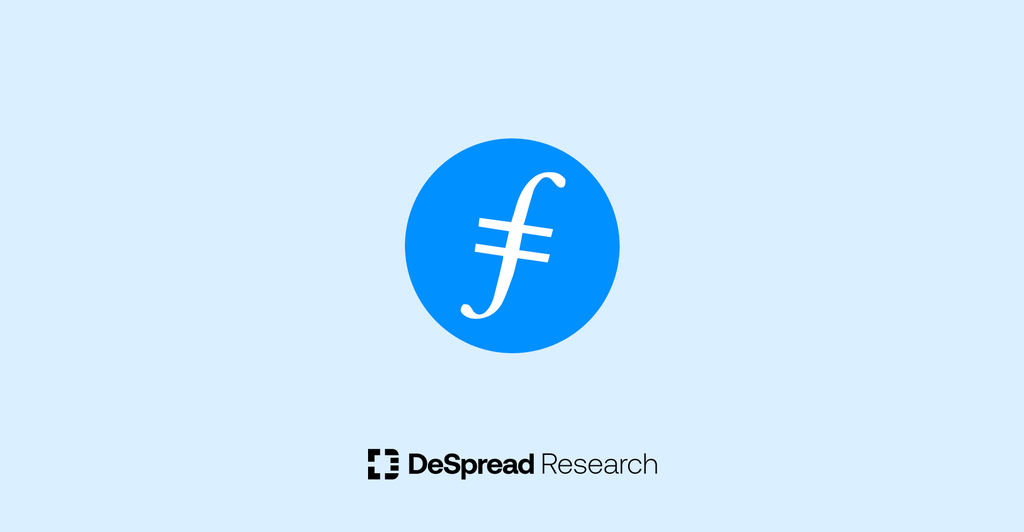
Filecoin — A Leap Towards Layer 1 through FVM
The transformation of large-scale data markets with the release of FVM

1. Introduction
Filecoin is widely recognized as a decentralized data storage platform, and many of us are familiar with it. There are several other similar services available, such as Arweave and Sia. However, Filecoin distinguishes itself by holding the majority of the total web3 storage capacity.
Recently, Filecoin has introduced the Filecoin Virtual Machine (FVM), which signifies a transformation from being solely a decentralized data storage platform to becoming a smart contract platform. The FVM is an execution environment that operates on the Filecoin network, enabling anyone to deploy EVM smart contracts once it is launched.
The motivation behind Filecoin’s decision to make this change stems from its direction and aspirations as a project. By introducing the FVM, Filecoin aims to expand its capabilities and achieve new objectives. In the following discussion, we will delve into Filecoin’s strategic vision and explore what they hope to accomplish with the introduction of the FVM.
2. Filecoin Master Plan and FVM Background
2.1. Filecoin Master Plan
Protocol Labs and Filecoin took part in EthDenver, a prominent blockchain conference held in early March, where they discussed their future objectives and aspirations. Colin Evran, the Ecosystem Lead at Protocol Labs, delivered a presentation outlining Filecoin’s goals, known as “The Filecoin Master Plan,” which can be summarized in the following three key areas:
- Build the world’s largest decentralized storage network
- Onboard & safeguard humanity’s data
- Bring compute to the data, to enable web-scale apps

Out of the three objectives above, the launch of the FVM is specifically aligned with the third goal. Enabling the deployment of smart contracts on the Filecoin network allows them to incorporate the immense potential of the open data economy within their ecosystem. To gain a deeper comprehension of these objectives, it is helpful to assess the progress made in relation to the first and second goals of the Filecoin Master Plan.
Step 1: Build the world’s largest decentralized storage network
- ~3,800 storage providers, decentralization across 44 countries, and over 13 exabytes of storage
- Over 20% of storage is actually in use by verified clients, which is 6.5x growth from just 3% in January 2022
- Collaborating with leading hardware suppliers including Seagate, AMD, Supermicro, and more
Step 2: Onboard & safeguard humanity’s data
Over 600 PiB of storage was used in February 2023, compared to only 24 PiB in January 2022, a nearly 25x growth
- Over 1,400 clients uploading data, with approximately 23% of them uploading over 100 TiB of data through services like Onramps and FIL+
- Over 100 large datasets from the scientific, public, and government sectors are stored on Filecoin
With these milestones, Filecoin now owns 99% of all Web3 storage capacity, and 96% of all Web3 storage in use is on the Filecoin network.
2.2. Creating web-scale applications with the FVM release
The Filecoin storage network has primarily functioned as a decentralized data storage platform, referred to as Layer 0. However, unlike existing Layer 1 networks like Ethereum, Filecoin lacked scalability beyond its storage capabilities.
The introduction of the FVM entails the integration of smart contracts into the Filecoin network, which essentially operates as a large-scale data marketplace. By incorporating smart contracts into a data marketplace, it not only expands access to storage but also opens up opportunities for various applications that can utilize the stored data. Furthermore, it enables the development of web-scale applications, as emphasized by Protocol Labs. The term “web-scale” refers to an environment that can deliver high-quality services through extensive cloud computing resources and infrastructure. The release of the FVM, enabling on-chain programmability, plays a crucial role in empowering the creation of web-scale applications that leverage the substantial amount of data present within the Filecoin network.
3. FVM Use Case Examples
Consequently, with the introduction of the FVM, the Filecoin network allows for greater diversity and flexibility in utilizing the available data. Protocol Labs provides the following examples of potential use cases that will be feasible on the Filecoin network following the launch of the FVM.
3.1. Data DAO
Data DAO is a decentralized autonomous organization designed to safeguard, curate, and promote the wider adoption of valuable datasets, including research databases, transaction records, or aggregated data. By tokenizing shares within a Data DAO, the worth and usefulness of a dataset can be objectively expressed and traded within the marketplace. The price associated with the services provided by a Data DAO operating on a particular dataset reflects its value. Additionally, the token is anticipated to facilitate the acquisition of related data or the performance of data analysis tasks.
3.2. Staking Protocol
The introduction of a staking protocol has the potential to greatly enhance the capital efficiency of the Filecoin network economy by establishing a natural connection between the liquidity of storage providers and token holders. This aims to streamline the accessibility of capital for all storage providers while evaluating risk factors through on-chain historical data, including details such as the issuance date of a provider’s address and any previous instances of slashing.
3.3. Storage Derivatives
Decentralized storage costs often exhibit dynamic characteristics rather than being fixed, which poses challenges for both storage clients and providers in terms of cost planning. However, the introduction of smart contracts brings about the ability for storage providers to design storage products with predetermined durations and anticipated costs. This allows storage demanders to accurately predict future costs and revenues without complications. The emergence of storage derivatives as a result of these smart contracts can contribute to market stabilization and generate fresh demand for storage services.
Furthermore, the utilization of the Filecoin network opens up possibilities for various use cases such as the development of insurance protocols, the potential for layer 2 solutions, and increased interoperability among different networks. As a result, we can anticipate the emergence of innovative services that leverage the extensive and diverse datasets present within the Filecoin network.
4. Analyzing the FVM Technology Stack
FVM is a WASM-based, multi-language executable virtual machine for IPLD data(distributed system data).

To facilitate a smooth transition for existing smart contract developers into the FVM environment, the FVM incorporates support for Ethereum contracts. This particular aspect of the FVM is sometimes referred to as FEVM. This compatibility is made possible through the concept of Multi-VM, which involves the integration of various Actors, including Foreign Actor and Navigate Actor, capable of executing smart contracts. Currently, only EVM is supported, but there are plans to extend support to all Actors compiled with technologies such as WASM, including SES and eBPF.
The compatibility is established at the bytecode level, enabling the utilization of existing Ethereum development tools. Developers can continue using their preferred tools, such as Truffle, Remix, Hardhat, VSCode plugins, and more, within the context of Filecoin. This allows for a seamless integration of familiar development workflows and toolsets when working with smart contracts on the Filecoin network.
Among the Actors, “Built-in Actors” are Actors that are hard-coded into the network and can be used to control the state of the global network or to control storage providers (SPs). These actors can be utilized to create DApps with functions specific to the Filecoin chain. Currently, there are 11 built-in actors supported, three of which are listed below.
- MinerActor: Provides methods to interact with SPs
- StorageMarketActor: Provides methods to manage storage
- MultiSig: Provides methods to perform multi-signatures
Furthermore, both the VM and SDK (Software Development Kit) for the Filecoin network are implemented using the Rust programming language. While the EVM functions as an interpreter, the FVM is constructed using Web Assembly (WASM) and compiled for efficient execution. This highlights the significant emphasis placed on performance considerations within the FVM, ensuring optimal operation while also maintaining compatibility.
5. FVM Roadmap

Since the introduction of the FVM concept by Raúl Kripalan, a researcher at Protocol Labs, in October 2021, Filecoin has been diligently working towards achieving milestones for the launch of the FVM. This effort has spanned over a year, with Milestone 2.1 scheduled to be completed on March 14, 2023. Once this milestone is reached, EVM contracts will become deployable on the Filecoin mainnet, enabling compatibility with existing Ethereum tooling on the Filecoin network.
Throughout 2023, several updates are still planned. Milestone 2.2 aims to enable the execution of smart contracts written in various programming languages. This expansion would allow a broader range of contributors to participate, as languages such as Rust and Go could be supported in addition to Solidity. Achieving this milestone would enhance the versatility and accessibility of the Filecoin network for smart contract development in different programming languages.
Furthermore, once Milestone 2.2 is accomplished, smart contracts will be supported natively within the FVM environment. This means that contracts can be executed with better performance and lower cost than the traditional FEVM. For existing developers, this is a welcome addition to optimization options for performance, as the relatively slow speed and high gas costs of the FEVM approach can be a burden for users.
In subsequent milestones like Milestone 3.0 and beyond, an increasing number of system functions will be made available as user permissions. This fosters an environment conducive to the development of a broader range of decentralized applications (dApps), including storage markets and incentivized features. Additionally, the introduction of cron functions and improved async call handling enhances the programming environment. Notably, the inclusion of cron functions allows for the implementation of contracts that operate at regular intervals, making it a valuable feature to apply in processes like data ETL (Extract, Transform, Load) automation.
6. Conclusion
Filecoin’s leap to Layer 1 with the introduction of the FVM sets it apart from other Layer 1 projects as a data storage platform. This distinction is highlighted by HQHan.eth, Ecosystem Growth at Protocol Labs, who emphasizes that Filecoin will serve as a Layer 1 solution for a distinct type of economy where real-world services hold a central position within the economic cycle. This unique positioning underscores Filecoin’s focus on integrating real-world services and its commitment to facilitating a specialized economic ecosystem.
13/x Filecoin bet cont’d
— HQHan.eth (@duckie_han) January 25, 2023
Seen in this light, @Filecoin is a bet on decentralized physical infrastructure - that this is a more effective way to coordinate the provision of increasingly scarce cloud services in a growing data economy.
It is intriguing that HQHan.eth characterizes Filecoin, which has been providing storage services to other layer 1 and layer 2 projects, as establishing its own “financial district” through the launch of the FVM.
The introduction of programmability within the Filecoin network is bound to foster a broader range of interactions than ever before, as outlined in Jnthnvctr’s article. The article offers several concrete examples of potential interactions, one of which is the “Auction Protocol” shown below.

- Before: Intermediaries play a role in validating clients and preventing malicious behavior
- After the update:
- Clients submit their requirements along with certain collateral to the smart contract
- Each storage provider bids to match the client’s requirements, triggering an auction
With this protocol design, we can envision new storage bidding services with trustless intermediaries. The list of new use cases is endless, and Filecoin is committed to onboarding developers and fostering the ecosystem through ongoing hackathons and acceleration programs.
21/x Traction and Quick Updates
— HQHan.eth (@duckie_han) January 25, 2023
Dev community:
- 120 teams in the FVM Foundry Program
- 400 hackers participated in first FEVM Hackathon (Nov'22)
- >900 hackers have registered for SpaceWarp Hackathon (CURRENT). Demo day on Mar 1. Sign up for updates: https://t.co/15pVvCBA82
Will this update differentiate Filecoin as a standout Layer 1 project? While the outcome remains uncertain, it is important to acknowledge that this development represents a novel and unprecedented approach within the ecosystem.